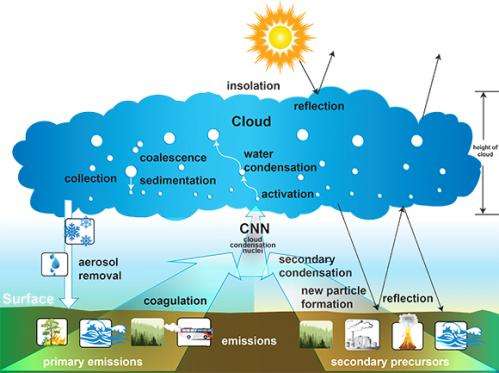The brass ring of climate modeling

Finding a simple way to express complex climate processes is the ultimate prize. Scientists at Pacific Northwest National Laboratory, University of Leeds, Colorado State University, the National Aeronautics and Space Administration (NASA), and Carnegie Mellon University developed a simple mathematical model to represent how atmospheric aerosol particles affect the Earth's energy balance through their role in forming cloud droplets. The simple model not only efficiently and effectively describes complex processes, but the results are consistent with those from much more detailed global climate simulations.
"Integrated assessment models used to explore emissions scenarios often use a crude treatment of aerosol indirect effect processes," said Dr. Steven J. Ghan, lead author and atmospheric scientist at PNNL. "Our model fills the need for a simple treatment with a stronger physical basis. The research team applied understanding of the physical mechanisms involved in a diverse set of global aerosol models."
How aerosol particles affect clouds is one of the most difficult challenges facing climate modelers because the processes involved are very complex. (See sidebar, Indirect and Direct Effects of Aerosols). Whether climate models represent this complexity depends on gathering and calculating all the relevant processes, and doing so at every grid cell of the model. This challenge is often formidable and can take an enormous amount of computational power. The simple model developed in this research is much more efficient and produces similar estimates of the global average impact of the aerosol indirect effect in a small fraction of time. This type of solution is useful for improving understanding of what determines the aerosol indirect effect. Scientists can also use it to run multi-century simulations with climate models designed to explore the impacts of different energy technology options.
The research team designed a simple model that uses physically based relationships between emissions, aerosol concentrations, droplet concentrations, cloud reflectance, and the Earth's energy balance, and accounts for spatial variations in both aerosols and clouds.
The model is now available to the university community as a teaching tool and to the integrated assessment community to better represent the complexity of the aerosol indirect effect.
More information: Ghan, S. et al. 2013. A Simple Model of Global Aerosol Indirect Effects, Journal of Geophysical Research Atmospheres 118:1-20. DOI: 10 1002/jgrd 50567
Journal information: Journal of Geophysical Research - Atmospheres
Provided by Pacific Northwest National Laboratory





















